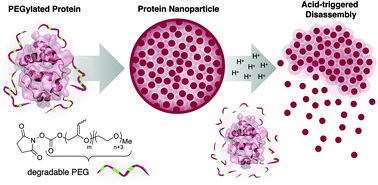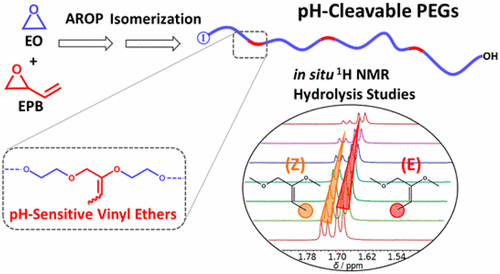|

E. Steiert, J. Ewald, A. Wagner, U. A. Hellmich, H. Frey, P. R. Wich, Polym. Chem. 2020, 11, 551-559.
|
Proteins represent a versatile biopolymer material for the preparation of nanoparticles. For drug delivery applications an acid-triggered disassembly and payload release is preferred. Herein, we present a protein nanoparticle system based on cytochrome c, which is surface-modified with acid-degradable polyethylene glycol (PEGylation). pH-Sensitivity was obtained through vinyl ether moieties distributed in the polyether backbone. When PEGylated, cytochrome c shows a different solubility behaviour in organic solvents, which allows for particle preparation using an emulsion-based solvent evaporation method. The resulting particles are stable under physiological conditions but degrade at acidic pH values.
|

M. Worm, D. Leibig, C. Dingels, H. Frey ACS Macro Lett., 2016, 5, 1357−1363.
|
Polyethylene glycol (PEG) has been used for decades to improve the pharmacokinetic properties of protein drugs, and several PEG-protein conjugates are approved by the FDA. However, the nondegradability of PEG restricts its use to a limiting molecular weight to permit renal excretion. In this work, we introduce a simple strategy to overcome the nondegradability of PEG by incorporating multiple pH-sensitive vinyl ether moieties into the polyether backbone. Copolymerization of 3,4-epoxy-1-butene (EPB) with ethylene oxide via anionic ring-opening polymerization (AROP) provides access to allyl moieties that can be isomerized to pH-cleavable propenyl units (isoEPB). The presence of a defined hydroxyl end group permits attachment to other functional molecules. The novel pH-degradable PEGs combine various desirable properties such as excellent long-term storage stability and cleavage in a physiologically relevant pH-range that render them promising candidates for biomedical application.
|